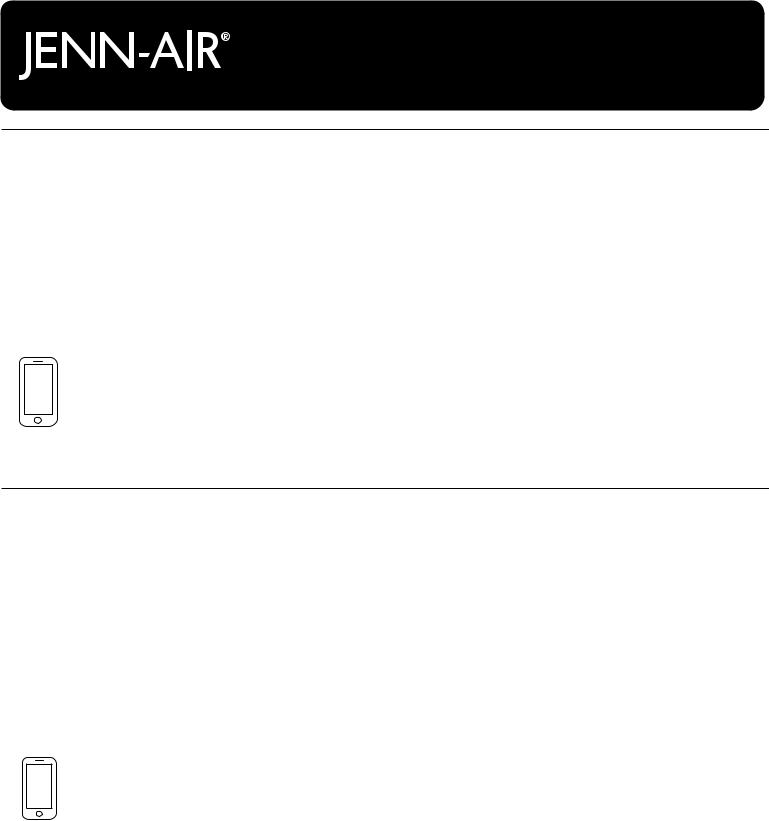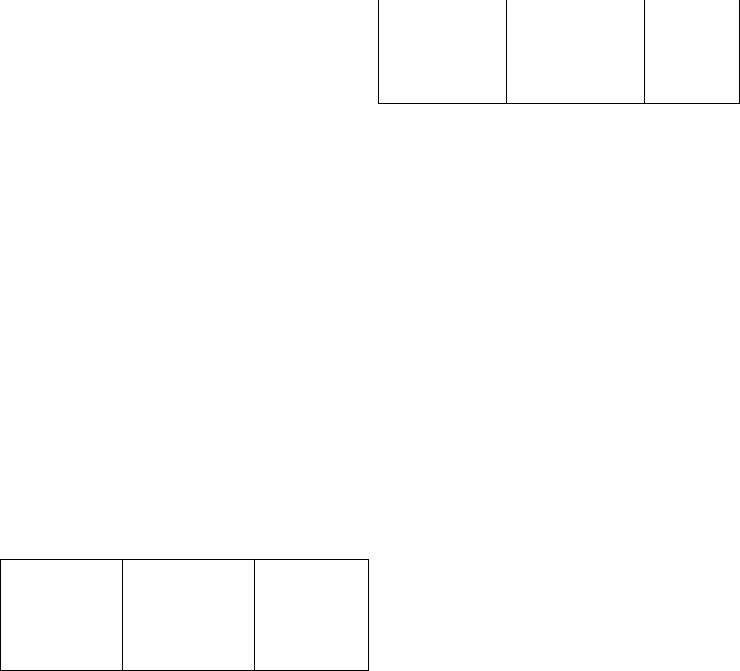Jenn-Air JDTSS246GS, JDTSS246GP Instruction Manual

Internet Connectivity Guide
Guide de connexion Internet
Get the App and Get Connected
With your mobile device, get the app, connectivity setup instructions, terms of use, and privacy policy at: www.jennair.com/connect
In Canada, visit www.jennair.ca/connect
and click on the Jenn-Air® Connected Appliances link.
IMPORTANT: Proper installation of your appliance prior to use is your responsibility. Be sure to read and follow the Installation Instructions that came with your appliance.
Connectivity requires Wi-Fi and account creation. App features and functionality subject to change. Data rates may apply. If you have any problems or questions, call Jenn-Air® Connected Appliances at 1-800-536-6247.
You Will Need:
■■ A home wireless router supporting Wi-Fi, preferably 2.4Ghz with WPA2 security. If you are unsure of your router’s capablilities, refer to the router manufacturer’s instructions.
SET UP ■■ The router to be on and have a live internet connection.
■■ The 10-character SAID code for your appliance. The SAID code is either printed on a label on the appliance or can be found on the LCD screen. Refer to the appliance User Guide for the location.
Once installed, launch the app. You will be guided through the steps to set up a user account and to connect your appliance. If you have any problems or questions, call Jenn-Air® Connected Appliances at 1-800-536-6247.
Obtenez l’application et connectez-vous
À l’aide de votre appareil mobile, obtenez l’application, les instructions de configuration de la connexion, les conditions d’utilisation et la politique de confidentialité au :
www.jennair.com/connect
Au Canada, visitez le www.jennair.ca/fr/connect
et cliquez sur le lien Jenn-Air® électroménager connecté
IMPORTANT : Il est de la responsabilité de l’utilisateur de bien installer l’appareil avant de l’utiliser. Bien lire et suivre le guide d’installation qui accompagne l’appareil.
La connexion requiert un lien Internet et la création d’un compte. Les fonctions de l’application peuvent changer. Des frais de transfert de données peuvent s’appliquer. En cas de problèmes ou pour toute question, communiquez avec l’équipe Jenn-Air® Connected Appliances au 1 800 536-6247.
Il vous faudra :
MISE EN PLACE
■■ Un routeur sans fil compatible Wi-Fi à 2,4 GHz, si possible avec sécurité WPA2. Pour vérifier les capacités de votre routeur, consultez le manuel d’instructions du fabricant du routeur.
■■ Le routeur devra être en marche et connecté à Internet.
■■ Le numéro SAID à 10 caractères de votre appareil. Le numéro SAID est imprimé sur une étiquette collée sur l’appareil ou peut être affiché à l’écran ACL. Consultez le guide d’utilisation de l’appareil pour connaître l’emplacement.
Une fois installée, lancez l’application. Suivez les étapes de configuration du compte d’utilisateur et de connexion de l’appareil. En cas de problèmes ou pour toute question, communiquez avec l’équipe Jenn-Air® Connected Appliances au 1 800 536-6247.
W11091317A

Connected Appliance Regulatory Notices
Federal Communications Commission (FCC) Compliance Notice
This equipment has been tested and found to comply with the limits for a Class B digital device, pursuant to Part 15 of the FCC Rules. These limits are designed to provide reasonable protection against harmful interference in a residential installation. This equipment generates, uses, and can radiate radio frequency energy and, if not installed and used in accordance with the instructions, may cause harmful interference to radio communications. However, there is no guarantee that interference will not occur in a particular installation. If this equipment does cause harmful interference to radio or television reception, which can be determined by turning the equipment off and on, the user is encouraged to try to correct the interference by one of the following measures:
–Reorient or relocate the receiving antenna.
–Increase the separation between the equipment and receiver.
–Connect the equipment into an outlet on a circuit different from that to which the receiver is connected.
–Consult the dealer or an experienced radio/TV technician for help.
This device complies with Part 15 of the FCC Rules. Operation is subject to the following two conditions:
1.This device may not cause harmful interference, and
2.This device must accept any interference received, including interference
that may cause undesired operation.
Changes or modifications not expressly approved by the party responsible for compliance could void the user’s authority to operate the equipment.
inférieur) approuvé pour l’émetteur par Industrie Canada. Dans le but de réduire les risques de brouillage radioélectrique à l’intention des autres utilisateurs, il faut choisir le type d’antenne et son gain de sorte que la puissance isotrope rayonnée équivalente (p.i.r.e.) ne dépasse pas l’intensité nécessaire à l’établissement d’une communication satisfaisante.
Le émetteurs radio IC : 10248A-WICHAM01 et 10248A-FLDAAM01 ont été approuvés par Industrie Canada pour fonctionner avec les types d’antenne énumérés ci-dessous et ayant un gain admissible maximal et l’impédance requise pour chaque type d’antenne. Les types d’antenne non inclus dans cette liste, ou dont le gain est supérieur au gain maximal indiqué, sont strictement interdits pour l’exploitation de l’émetteur.
Type d’antenne |
Gain admissible |
L’impédance |
|
maximal d’antenne (dBi) |
requise (OHM) |
À fentes |
1,2 |
50 |
Monopôle (WICHAM01 |
0,5 |
50 |
seulement) |
|
|
Dipole |
3,0 |
50 |
F |
1,60 |
50 |
Planaire F |
4,2 |
50 |
Pour satisfaire aux exigences de la FCC et IC d’exposition aux radiofréquences, une distance de séparation de 20 cm ou plus doit être maintenue entre cet appareil et des personnes lors de fonctionnement du dispositif. Pour assurer la conformité des opérations au plus près que cette distance n’est pas recommandée. L’antenne utilisée pour ce transmetteur ne doit pas être co-localisés en conjonction avec toute autre antenne ou transmetteur.
RF Exposure Information
To comply with FCC/IC RF exposure requirements for mobile transmitting devices, this transmitter should only be used or installed at locations where there is at least 20 cm separation distance between the antenna and all persons.
To comply with FCC/IC RF exposure limits for general population/uncontrolled exposure, the antenna(s) used for this transmitter must be installed to provide a separation distance of at least 20 cm from all persons and must not be co-located or operating in conjunction with any other antenna or transmitter.
Industry Canada (IC) Compliance Notice
This Device complies with Industry Canada License-exempt RSS standard(s). Operation is subject to the following two conditions:
1.This device may not cause interference,
2.This device must accept any interference, including interference that may cause undesired operation of the device.
Under Industry Canada regulations, this radio transmitter may only operate using an antenna of a type and maximum (or lesser) gain approved for the transmitter by Industry Canada. To reduce potential radio interference to other users, the antenna type and its gain should be so chosen that the equivalent isotropically radiated power (e.i.r.p.) is not more than that necessary for successful communication.
The radio transmitters IC: 10248A-WICHAM01 and 10248A-FLDAAM01 have been approved by Industry Canada to operate with the antenna types listed below with the maximum permissible gain and required antenna impedance for each antenna type indicated. Antenna types not included in this list, having a gain greater than the maximum gain indicated for that type, are strictly prohibited for use with this device.
Antenna Type |
Maximum Permissible |
Required |
|
Antenna Gain (dBi) |
Impendance (OHM) |
Slot |
1.2 |
50 |
Monopole |
0.5 |
50 |
(WICHAM01 only) |
|
|
Dipole |
3.0 |
50 |
F |
1.60 |
50 |
Planar F |
4.2 |
50 |
To comply with FCC and Industry Canada RF radiation exposure limits for general population, the antenna(s) used for this transmitter must be installed such that a minimum separation distance of 20 cm is maintained between the radiator (antenna) and all persons at all times and must not be colocated or operating in conjunction with any other antenna or transmitter.
Le présent appareil est conforme aux CNR d’Industrie Canada applicables aux appareils radio exempts de licence. L’exploitation est autorisée aux deux conditions suivantes :
(1)l’appareil ne doit pas produire de brouillage, et
(2)l’utilisateur de l’appareil doit accepter tout brouillage radioélectrique subi, même si le brouillage est susceptible d’en compromettre le fonctionnement. Conformément à la réglementation d’Industrie Canada, le présent émetteur
radio peut fonctionner avec une antenne d’un type et d’un gain maximal (ou
OEM Responsibilities to comply with FCC and Industry Canada Regulations
The WICHAM01 / FLDAAM01 Modules have been certified for integration into products only by OEM integrators under the following conditions:
1.The antenna(s) must be installed such that a minimum separation distance of 20 cm is maintained between the radiator (antenna) and all persons at all times.
2.The transmitter module must not be co-located or operating in conjunction with any other antenna or transmitter.
As long as the two conditions above are met, further transmitter testing will not be required. However, the OEM integrator is still responsible for testing their end-product for any additional compliance requirements required with this module installed (for example, digital device emissions, PC peripheral requirements, etc.).
IMPORTANT NOTE: In the event that these conditions cannot be met (for certain configurations or co-location with another transmitter), then the FCC and Industry Canada authorizations are no longer considered valid and the FCC ID and IC Certification Number cannot be used on the final product. In these circumstances, the OEM integrator will be responsible for reevaluating the end product (including the transmitter) and obtaining a separate FCC and Industry Canada authorization.
End Product Labeling
The WICHAM01 / FLDAAM01 Modules are labeled with FCC ID and IC Certification Number. If the FCC ID and IC Certification Number are not visible when the module is installed inside another device, then the outside of the device into which the module is installed must also display a label referring to the enclosed module. In that case, the final end product must be labeled in a visible area or display the following:
“Contains FCC ID: A5UWICHAM01”
“Contains IC: 10248A-WICHAM01” or
“Contains FCC ID: A5UFLDAAM01”
“Contains IC: 10248A-FLDAAM01”
The OEM of the WICHAM01 / FLDAAM01 Module must only use the approved antenna(s), which have been certified with this module. The OEM integrator has to be aware not to provide information to the end user regarding how to install or remove this RF module or change RF related parameters in the user manual of the end product.
The user manual for the end product must include the following information in a prominent location:
“To comply with FCC and Industry Canada RF radiation exposure limits for general population, the antenna(s) used for this transmitter must be installed such that a minimum separation distance of 20 cm is maintained between the radiator (antenna) and all persons at all times and must not be colocated or operating in conjunction with any other antenna or transmitter.”
